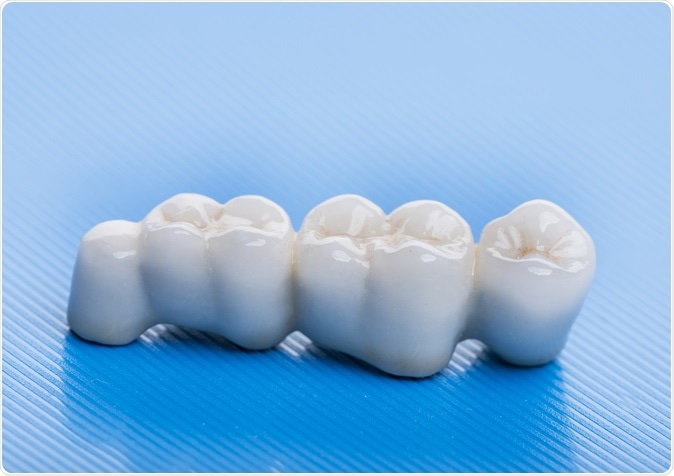Patients who have undergone a dental bridge procedure should be advised as to the best ways to care for the bridge to prolong its lifespan.
Fortunately, a dental bridge that has been properly placed usually allows patients to eat and chew normally, without causing significant changes. However, particular attention should be paid to the dental care routine to look after the bridge and help it to last.

Image Credit: Kuttelvaserova Stuchelova / Shutterstock
Initial Sensitivity and Discomfort
In the first few days after the dental appointment to place a bridge, it is common for patients to experience some tooth sensitivity, particularly when eating hot or cold foods. Individuals who are affected by this may benefit from using toothpaste designed for sensitive teeth. The sensitivity tends to subside within several days without any intervention.
It may also take some time for patients to grow accustomed to feel of the new bridge in their mouth, which is considered normal. If the bite continues to feel abnormal even several days after the procedure, there is a possibility that the bridge may have been placed incorrectly and it is worthwhile to have it checked by a dental professional. This is important because an ill-fitting bridge can affect the teeth of the opposite jaw and affect the bite.
Recommended Oral Care
Tooth decay underneath the crowns that hold up the dental bridge is one of the most common problems associated with dental bridges. It is possible for food to lodge beneath or beside the bridge, which can lead to the build up of plaque and tooth decay. In severe cases, this weakens the abutment teeth and may cause the bridge to fail.
A dental bridge is expected to last longer than ten years if the patient pays attention to its care. To prolong the useful lifespan of a dental bridge the following oral care techniques are recommended:
- Brush teeth twice a day with a fluoride toothpaste
- Floss with care daily between natural teeth and underneath the bridge
- Rinse teeth with a fluoride wash regularly if desired
- Have teeth professionally cleaned by a dentist or dental hygienist regularly
- Attend regular dental check-ups to assess the health of the bridge
These oral care tips are important for maintaining the health of the dental bridge and the surrounding teeth. It is also useful for gum health and the prevention of gingivitis and periodontitis.
Dietary Tips for Permanent Dental Bridges
Although patients who have a dental bridge can generally eat a varied healthy diet with no particular restrictions due to the bridge, some tips help to reduce damage to the bridge.
It should be recognized that dental bridges will never be as strong and durable as natural teeth and should not be treated as such. With this in mind, the bridge should not be used in an exaggerated manner while chewing. Moreover, some problematic foods, such as nut shells and hard candy, should be avoided. It can also help to eat a diet with a high intake of fresh fruits and vegetables.
Dietary Tips for Temporary Dental Bridges
The dental bridge procedure typically takes two dental appointments to allow for the bridge to be constructed to fit the patient’s mouth shape in between the two appointments. In most cases, a temporary bridge or crowns are placed in the meantime to protect the abutment teeth that have been shaped for the permanent dental bridge placement. This temporary dental bridge usually requires more care when eating and using it because it is not fixed in place as strongly.
In particular, patients should be advised to avoid eating very chewy or hard foods, such as gum, crusty bread and hard candy. This is because these types of foods may sometimes cause the bridge to become dislodged. In the event that the bridge does fall out, the patient should seek professional help to replace the bridge rather than try to fix it in place themselves.
References
Further Reading